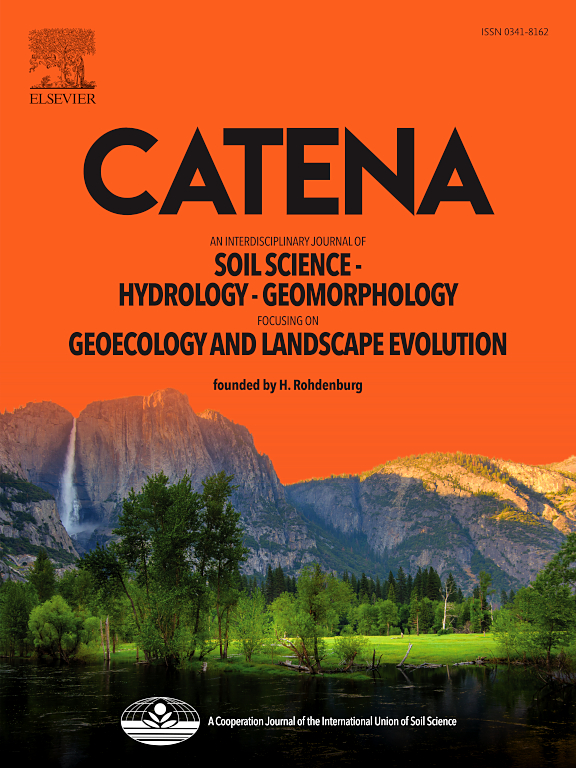恢复不同长度高寒草甸土壤有机碳及其形态随海拔的变化
IF 5.7
1区 农林科学
Q1 GEOSCIENCES, MULTIDISCIPLINARY
引用次数: 0
摘要
土壤有机碳(SOC)在全球碳循环中起着至关重要的作用,但人们对不同长度的退化高寒草甸恢复斑块中土壤有机碳的变化(及其形式)与海拔的关系知之甚少。研究了海拔高度和斑块状退化草甸恢复周期对青藏高原高寒草甸表层有机碳及其形态的影响。通过结构方程模型(SEM)确定了环境因子影响土壤有机碳及其形态的关键途径。结果表明:土壤有机碳(SOC)、轻组分有机碳(LFOC)、重组分有机碳(HFOC)、溶解有机碳(DOC)、易氧化有机碳(EOC)、颗粒有机碳(POC)与海拔高度呈负相关,微生物生物量碳(MBC)与海拔高度呈正相关。SOC及其形态与采油长度呈显著正相关,0.5 ~ 30年间,SOC、LFOC、HFOC、DOC、MBC、EOC和POC分别增加了20.67%、23.10%、20.64%、27.35%、36.98%、16.13%和33.62%。土壤有机碳含量及其形态呈显著下降趋势(P <;在较短的恢复周期内,土壤有机碳对海拔高度更加敏感。个别情况下,恢复长度对土壤有机碳变化的影响大于海拔高度,但只有在一定阈值之后才会发生变化。海拔通过多种机制途径调节有机碳动力学。SEM结果表明,恢复长度对DOC、MBC、POC、TC和SC有直接的正向影响(通径系数分别为0.823、0.715、0.489、0.879和0.586)。高程对土壤有机碳、温度和土壤含水量有直接的负向影响(路径系数分别为- 0.674、- 0.639和- 0.808),对土壤POC和降水有直接的正向影响(路径系数分别为0.388和1.127)。其次,通过降水,高程对DOC和MBC有明显的影响。此外,海拔通过影响温度和降水间接影响DOC、POC和MBC。退化斑块恢复过程中,土壤有机碳含量的空间分布受海拔和植被特征、土壤理化性质等生态系统因子的调控。因此,斑块状退化高寒草甸的恢复应优先考虑植被恢复和人工增雨。本研究为高寒草甸土壤有机碳管理提供了理论依据,并提出了在不同海拔带实施差异化恢复措施的建议。本文章由计算机程序翻译,如有差异,请以英文原文为准。
Changes in soil organic carbon and its forms in recovering alpine meadows of various lengths in relation to altitude
Soil organic carbon (SOC) plays a crucial role in the global carbon cycle, but little is known about its changes (and its forms) in recovering patches of degraded alpine meadows of various lengths in relation to altitude. This study explores how altitude and the recovering period of patchily degraded meadow affect surface layer SOC and its forms in alpine meadow on the Qinghai-Tibet Plateau. The key pathways of environmental factors influencing SOC and its forms were determined via structural equation modeling (SEM). The results showed that SOC, light fraction organic carbon (LFOC), heavy fraction organic carbon (HFOC), dissolved organic carbon (DOC), easily oxidizable organic carbon (EOC) and particulate organic carbon (POC) exhibit negative correlations with elevation, whereas microbial biomass carbon (MBC) shows a positive correlation. SOC and its forms exhibit positive correlations with recovery length, SOC, LFOC, HFOC, DOC, MBC, EOC and POC increased by 20.67 %, 23.10 %, 20.64 %, 27.35 %, 36.98 %, 16.13 % and 33.62 % from 0.5 to 30 years. The content of SOC and its forms exhibited a significant downward trend (P < 0.05) with elevation in a shorter period of recovery, over which SOC became more sensitive to altitude. Individually, recovery length is more important to SOC variation than altitude, but only after a certain threshold. Altitude regulates SOC dynamics via multiple mechanistic pathways. SEM showed that recovery length had a direct positive effect on DOC, MBC, POC, TC, and SC (path coefficients of 0.823, 0.715, 0.489, 0.879, and 0.586, respectively). Elevation had direct negative effects on SOC, temperature and soil water content (path coefficients of −0.674, −0.639, −0.808, respectively), while exhibiting direct positive effects on POC and precipitation (path coefficients of 0.388 and 1.127, respectively). Secondly, through precipitation, elevation specifically influenced DOC and MBC. Additionally, elevation indirectly affected DOC, POC and MBC by influencing temperature and precipitation. The spatial distribution of SOC content is regulated by altitude and ecosystem factors such as vegetation characteristics and soil physicochemical properties during the recovery of degraded patches. Therefore, vegetation restoration and artificial precipitation enhancement should be prioritized in the rehabilitation of patchily degraded alpine meadows. This study provides a theoretical foundation for SOC management in alpine meadows, and recommends implementing differentiated restoration measures across various elevational zones.
求助全文
通过发布文献求助,成功后即可免费获取论文全文。
去求助
来源期刊

Catena
环境科学-地球科学综合
CiteScore
10.50
自引率
9.70%
发文量
816
审稿时长
54 days
期刊介绍:
Catena publishes papers describing original field and laboratory investigations and reviews on geoecology and landscape evolution with emphasis on interdisciplinary aspects of soil science, hydrology and geomorphology. It aims to disseminate new knowledge and foster better understanding of the physical environment, of evolutionary sequences that have resulted in past and current landscapes, and of the natural processes that are likely to determine the fate of our terrestrial environment.
Papers within any one of the above topics are welcome provided they are of sufficiently wide interest and relevance.
 求助内容:
求助内容: 应助结果提醒方式:
应助结果提醒方式:


